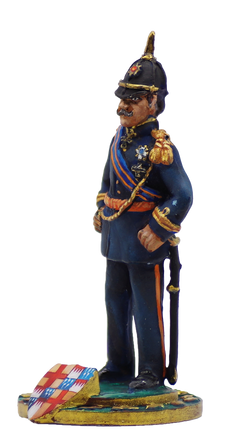
Adolph Frederik Lodewijk
Count van Rechteren Limpurg Almelo
Adolph Frederik Lodewijk graaf van Rechteren Limpurg Almelo (Huis Almelo, 21 August 1865 – Wassenaar, 20 March 1935) was commissioner of the Queen in Overijssel from 1909 to 1925. In this position, he worked for the modernization of the infrastructure of the province of Overijssel and supported large-scale construction projects such as the IJsselcentrale. He was a grandson of the politician Jacob Hendrik van Rechteren van Appeltern.


The Royal Netherlands Marine Corps (Dutch: Korps Mariniers) is the elite naval infantry corps of the Royal Netherlands Navy. The marines trace their origins to the establishment of the Regiment de Marine on 10 December 1665, by the then grand pensionary of the Dutch Republic, Johan de Witt and famous Admiral Michiel de Ruyter. It is the second-oldest still-active marine corps in the world. The corps was founded on 10 December 1665 during the Second Anglo-Dutch War by the then grand pensionary of the Dutch Republic, Johan de Witt, and Admiral Michiel de Ruyter as the Regiment de Marine. The first commander of the corps was Willem Joseph van Ghent. The Dutch had successfully used conventional troops embarked on ships during the First Anglo-Dutch War. The Korps Mariniers was the fifth European Marine unit formed, being preceded by Spain's Infantería de Armada (1537), the Portuguese Marine Corps (1610), France's Troupes de marine (1622) and the English Royal Marines (1664), although the Dutch Marines were the first in history to specialise in amphibious operations. Like Britain, the Netherlands has had several periods during which its Marine Corps were disbanded. The French occupation of The Netherlands, which lasted from 1810 until 1813, is an example of such disbandments. A new Marine unit was raised on 20 March 1801 during the time of the Batavian Republic and on 14 August 1806 the Korps Koninklijke Grenadiers van de Marine was raised under King Louis Bonaparte. The modern Korps Mariniers dates back to 1814, receiving its current name in 1817.
In 1667, led by Admiral van Ghent, and their new commander, the Englishman Colonel Thomas Dolman, the Regiment de Marine played a prominent part in the Dutch raid on the Medway in Kent (10–14 June). The Korps' battle honour "Chatham" is one of the few ever won on British soil by a foreign unit. The July 2nd attack on Landguard fort near Harwich, performed by 1,500 Mariniers after landing at Woodrich was defeated by the English. The mariniers also fought in the Franco-Dutch War and Third Anglo-Dutch War. On 29 June 1672, after serving in the Battle of Solebay, two-thirds of the Marines were withdrawn from the Dutch States Navy and formed into a brigade in order to reinforce the Dutch States Army, which consisted largely of mercenaries, in anticipation of a potential English invasion. They returned to their ships in time to help prevent any such invasion by defeating a Anglo-French fleet at the Battle of Texel on 21 August 1673. Led by Gerolf van Isselmuyden, they served in the land battle of Seneffe against the French in 1674. Dutch support for American independence led to the Fourth Anglo-Dutch War, where the mariniers served at Dogger Bank. In 1704, Marines were part of a combined English-Dutch force under Prince George of Hesse-Darmstadt that captured Gibraltar and defended it successfully shortly afterwards. The cooperation with the British was repeated once again during the Bombardment of Algiers in 1816. The Korps Mariniers served in various colonial operations of the Dutch Empire in the Dutch East Indies. The gradual conquest of the colony and operations consolidating Dutch rule lasted from the 1850s until shortly before World War I. The battle honours from the Aceh War (1873–1913) and Bali are displayed on the Corps' colour.

The House of Rechteren (also Van Rechteren Limpurg) is the name of an old noble family belonging to the Dutch and German nobility. The German branch of Counts von Rechteren-Limpurg-Speckfeld has been mediatised. The family was already noble from earliest times ("Uradel"). The first documented ancestor is Fredericus van Hekeren van der Ese (mentioned 1295) who was an adviser to Reginald II of Guelders. His grandson Frederik van Heeckeren van der Eze (1320-ca. 1386) was the head of the Heeckerens faction during the War of the Guelderian Succession. Through his marriage with 'Lutgardis van Voorst, whose ancestors owned both the castle Rechteren near Dalfsen as well as the castle Voorst near Zwolle, the surname van Rechteren entered the family. In 1432, Frederik's grandson, Frederik van Hekeren genaamd van Rechteren († 1462) married Cunegonde van Polanen. Their son Otto van Hekeren genaamd van Rechteren († 1478) inherited Castle Rechteren and became the ancestor of the
counts of Rechteren. Otto's brother, Zeger van Hekeren genaamd van Voorst, became the ancestor of the present-day barons van Voorst tot Voorst. The van Heeckeren family is related to both families. In 1705, Joachim Heinrich Adolf van Rechteren was granted by Emperor Joseph I. the Imperial Count. His son, Johann Eberhard Adolf (1714-1754), inherited from his mother, Countess Amalie zu Limpurg-Speckfeld, the county of Limpurg-Speckfeld. In 1806 the branch of Rechteren-Limpurg-Speckfeld was mediatised. Castle Rechteren in Dalfsen became a property of Herman van Voorst, ancestor of the Rechteren family, in 1315. and it is still owned by the family. The family also owns Huize Almelo and the Enghuizen estate.
Awards: Sash and star of the Order of the Lion of the Netherlands (De Orde van de Nederlandse Leeuw), Insignia and star of the Teutonic Order (Duitse Orde).






